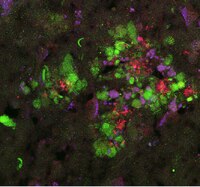ABN1723 Sigma-AldrichAnti-RTN3 (R458)
Anti-RTN3 (R458) Antibody, Cat. No. ABN1723, is a highly specific rabbit polyclonal antibody that targets RTN3 and has been tested in and Immunofluorescence, Immunohistochemistry, Immunoprecipitation, and Western Blotting.
More>> Anti-RTN3 (R458) Antibody, Cat. No. ABN1723, is a highly specific rabbit polyclonal antibody that targets RTN3 and has been tested in and Immunofluorescence, Immunohistochemistry, Immunoprecipitation, and Western Blotting. Less<<Recommended Products
개요
| Replacement Information |
|---|
주요 사양표
| Species Reactivity | Key Applications | Host | Format | Antibody Type |
|---|---|---|---|---|
| H, M | IF, IHC, IP, WB | Rb | Unpurified | Polyclonal Antibody |
| References |
|---|
| Product Information | |
|---|---|
| Format | Unpurified |
| Presentation | Rabbit polyclonal antibody serum with 0.05% sodium azide. |
| Quality Level | MQ100 |
| Physicochemical Information |
|---|
| Dimensions |
|---|
| Materials Information |
|---|
| Toxicological Information |
|---|
| Safety Information according to GHS |
|---|
| Safety Information |
|---|
| Packaging Information | |
|---|---|
| Material Size | 100 µL |
| Transport Information |
|---|
| Supplemental Information |
|---|
| Specifications |
|---|
| Global Trade Item Number | |
|---|---|
| 카탈로그 번호 | GTIN |
| ABN1723 | 04054839057922 |
Documentation
Anti-RTN3 (R458) MSDS
| 타이틀 |
|---|
Anti-RTN3 (R458) Certificates of Analysis
| Title | Lot Number |
|---|---|
| Anti-RTN3 (R458) - 3487521 | 3487521 |
| Anti-RTN3 (R458) - 3877998 | 3877998 |
| Anti-RTN3 (R458) Polyclonal Antibody | 3048270 |
| Anti-RTN3 (R458) Polyclonal Antibody | 3109186 |









